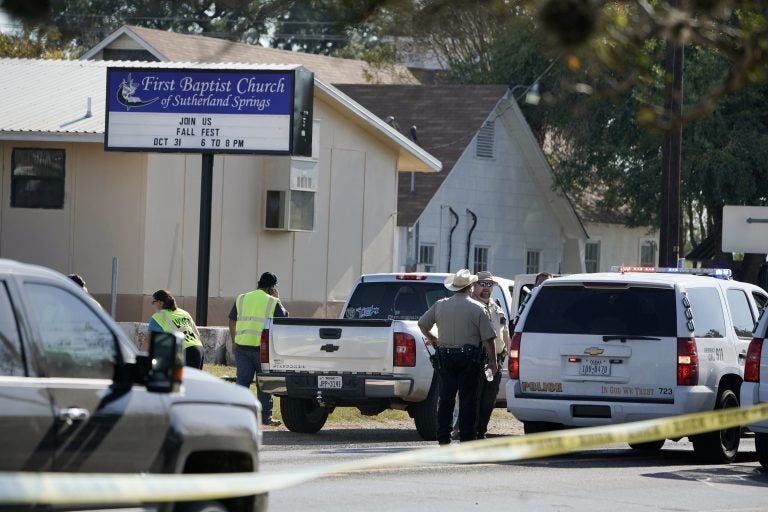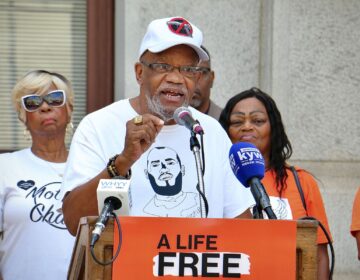26 killed in church attack in Texas’ deadliest mass shooting
A man dressed in black tactical-style gear and armed with an assault rifle opened fire inside a church in South Texas on Sunday, killing 26 people and wounding about 20 others

Law enforcement officers gather in front of the First Baptist Church of Sutherland Springs after a fatal shooting, Sunday, Nov. 5, 2017, in Sutherland Springs, Texas. (AP Photo/Darren Abate)
A man dressed in black tactical-style gear and armed with an assault rifle opened fire inside a church in a small South Texas community on Sunday, killing 26 people and wounding about 20 others in what the governor called the deadliest mass shooting in the state’s history. The dead ranged in age from 5 to 72 years old.
Authorities didn’t identify the attacker during a news conference Sunday night, but two other officials — one a U.S. official and one in law enforcement — identified him as Devin Kelley. They spoke to The Associated Press on the condition of anonymity because they weren’t authorized to discuss the investigation.
The U.S. official said Kelley lived in a San Antonio suburb and didn’t appear to be linked to organized terrorist groups. Investigators were looking at social media posts Kelley made in the days before Sunday’s attack, including one that appeared to show an AR-15 semiautomatic weapon.
Kelley received a bad-conduct discharge from the Air Force for allegedly assaulting his spouse and child, and was sentenced to 12 months’ confinement after a 2012 court-martial. Kelley served in Logistics Readiness at Holloman Air Force Base in New Mexico from 2010 until his discharge, Air Force spokeswoman Ann Stefanek said.
At the news conference, the attacker was described only as a white man in his 20s who was wearing black tactical gear and a ballistic vest when he pulled into a gas station across from the First Baptist Church in Sutherland Springs, about 30 miles southeast of San Antonio, around 11:20 a.m.
The gunman crossed the street and started firing a Ruger AR rifle at the church, said Freeman Martin, a regional director of the Texas Department of Safety, then continued firing after entering the white wood-frame building, where an 11 a.m. service was scheduled.
Wilson County Sheriff Joe D. Tackitt Jr., whose territory includes Sutherland Springs, said there was likely “no way” for the church congregation to escape once the shooting started.
“You’ve got your pews on either side. He just walked down the center aisle, turned around and my understanding was shooting on his way back out,” said Tackitt, who said the shooter also carried a handgun but that he didn’t know if it was fired.
Tackitt described the scene inside the church as “terrible.”
“It’s unbelievable to see children, men and women, laying there. Defenseless people,” Tackitt said. “I guess it was seeing the children that were killed. It’s one thing to see an adult, but to see a 5-year-old …”
As he left, the shooter was confronted by an armed resident who “grabbed his rifle and engaged that suspect,” Martin said. A short time later, the suspect was found dead in his vehicle at the county line.
Several weapons were found inside the vehicle and Martin said it was unclear if the attacker died of a self-inflicted wound or if he was shot by the resident who confronted him. He said investigators weren’t ready to discuss a possible motive. Martin said 23 of the dead were found in the church, two were found outside and one died after being taken to a hospital.
The man who confronted Kelley had help from another local resident, Johnnie Langendorff, who told KSAT TV that he was driving past the church as the shooting happened. He didn’t identify the armed resident but said the man exchanged gunfire with the gunman, then asked to get in Langendorff’s truck and the pair pursued as the gunman drove away.
Langendorff says the gunman eventually lost control of his vehicle and crashed. He says the other man walked up to the vehicle with his gun drawn and the suspect did not move. He stayed there for at least five minutes, until police arrived.
“I was strictly just acting on what’s the right thing to do,” Langendorff said.
Gov. Greg Abbott called the attack the worst mass shooting in Texas history.
“There are no words to describe the pure evil that we witnessed,” Abbott said. “Our hearts are heavy at the anguish in this small town, but in time of tragedy, we see the very best of Texas. May God comfort those who’ve lost a loved one, and may God heal the hurt in our communities.”
Among those killed was the church pastor’s 14-year-old daughter, Annabelle Pomeroy. Pastor Frank Pomeroy, and his wife, Sherri, were both out of town when the attack occurred, Sherri Pomeroy wrote in a text message.
“We lost our 14-year-old daughter today and many friends,” she wrote. “Neither of us has made it back into town yet to personally see the devastation. I am at the charlotte airport trying to get home as soon as i can.”
Federal agents swarmed the small rural community of a few hundred residents, including ATF investigators and the FBI’s evidence collection team.
Alena Berlanga, a resident of nearby Floresville, known for its annual peanut festival, said everyone knows everyone else in the sparsely populated county.
“Everybody’s going to be affected and everybody knows someone who’s affected,” Berlanga said.
Church member Nick Uhlig, 34, wasn’t at Sunday’s service, said his cousin, who was 8 months pregnant, and her in-laws were among those killed.
“We just gathered to bury their grandfather on Thursday,” he said, shaking his head.
President Donald Trump, who was in Japan, called the shooting an “act of evil” and said he was monitoring the situation.
Later Sunday, two sheriff’s vans were parked outside the gate of a cattle fence surrounding the address listed for Kelley on the rural, western outskirts of New Braunfels, north of San Antonio.
Ryan Albers, 16, who lives across the road, said he heard intensifying gunfire coming from that direction in recent days.
“It was definitely not just a shotgun or someone hunting,” Albers said. “It was someone using automatic weapon fire.”
The church has posted videos of its Sunday services on a YouTube channel, raising the possibility that the shooting was captured on video.
In a video of its Oct. 8 service, a congregant who spoke and read Scripture pointed to the Oct. 1 Las Vegas shooting a week earlier as evidence of the “wicked nature” of man. That shooting left 58 dead and more than 500 injured.
Until Sunday, the deadliest mass shooting in Texas had been a 1991 attack in Killeen, when a mentally disturbed man crashed his pickup truck through a restaurant window at lunchtime and started shooting people, killing 23 and injuring more than 20 others.
The University of Texas was the site of one of the most infamous mass shootings in modern American history, when U.S. Marine sniper Charles Whitman climbed the Austin campus’ clock tower in 1966 and began firing on stunned people below, killing 13 and wounding nearly three dozen others. He had killed his wife and mother before heading to the tower, one victim died a week later and medical examiners eventually attributed a 17th death to Whitman in 2001.
___
Associated Press writers Sadie Gurman and Eric Tucker in Washington, Nomaan Merchant in Houston, Will Weissert in Austin, Diana Heidgerd in Dallas, Michael Balsamo in Los Angeles and Paul J. Weber in New Braunfels, Texas, contributed to this report.
Here’s a look at some of the nation’s deadliest mass shootings since 2012:
— Oct. 1, 2017: A gunman identified by authorities as Stephen Paddock opened fire on an outdoor music festival on the Las Vegas Strip from the 32nd floor of a hotel-casino, killing 58 people and wounding more than 500. SWAT teams with explosives then stormed his room and found he had killed himself.
— June 12, 2016: Gunman Omar Mateen opened fire at an Orlando, Florida, nightclub, killing 49 people. Mateen was later killed in a shootout with police.
— Feb. 25, 2016: Cedric Ford, 38, killed three people and wounded 14 others at a lawnmower factory where he worked in the central Kansas community of Hesston. The local police chief killed him during a shootout with 200 to 300 workers still in the building, authorities said.
— Feb. 20, 2016: Jason Dalton, 45, is accused of randomly shooting and killing six people and severely wounding two others during a series of attacks over several hours in the Kalamazoo, Michigan, area. Authorities say he paused between shootings to make money as an Uber driver. He faces murder and attempted-murder charges.
— Dec. 2, 2015: Syed Rizwan Farook, 28, and Tashfeen Malik, 27, opened fire at a social services center in San Bernardino, California, killing 14 people and wounding more than 20. They fled the scene but died hours later in a shootout with police.
— Oct. 1, 2015: A shooting at Umpqua Community College in Roseburg, Oregon, left 10 people dead and seven wounded. Shooter Christopher Harper-Mercer, 26, exchanged gunfire with police, then killed himself.
— June 17, 2015: Dylann Roof, 21, shot and killed nine African-American church members during a Bible study group inside the Emanuel African Methodist Episcopal Church in Charleston, South Carolina. Police contend the attack was racially motivated. Roof has been sentenced to death in the shootings.
— May 23, 2014: A community college student, Elliot Rodger, 22, killed six people and wounded 13 in shooting and stabbing attacks in the area near the University of California, Santa Barbara, campus. Authorities said he apparently shot himself to death after a gunbattle with deputies.
— Sept. 16, 2013: Aaron Alexis, a mentally disturbed civilian contractor, shot 12 people to death at the Washington Navy Yard before he was killed in a police shootout.
— July 26, 2013: Pedro Vargas, 42, went on a shooting rampage at his Hialeah, Florida, apartment building, gunning down six people before officers fatally shot him.
— Dec. 14, 2012: In Newtown, Connecticut, an armed 20-year-old man entered Sandy Hook Elementary School and used a semi-automatic rifle to kill 26 people, including 20 first-graders and six adult school staff members. He then killed himself.
— Sept. 27, 2012: In Minnesota’s deadliest workplace rampage, Andrew Engeldinger, who had just been fired, pulled a gun and fatally shot six people, including the company’s founder. He also wounded two others at Accent Signage Systems in Minneapolis before taking his own life.
— Aug. 5, 2012: In Oak Creek, Wisconsin, 40-year-old gunman Wade Michael Page killed six worshippers at a Sikh Temple before killing himself.
—July 20, 2012: James Holmes, 27, fatally shot 12 people and injured 70 in an Aurora, Colorado, movie theater. He was sentenced to life in prison without parole.
— April 2, 2012: Seven people were killed and three were wounded when a 43-year-old former student opened fire at Oikos University in Oakland, California. One Goh was charged with seven counts of murder and three counts of attempted murder, but psychiatric evaluations concluded he suffered from long-term paranoid schizophrenia and was unfit to stand trial.
WHYY is your source for fact-based, in-depth journalism and information. As a nonprofit organization, we rely on financial support from readers like you. Please give today.




